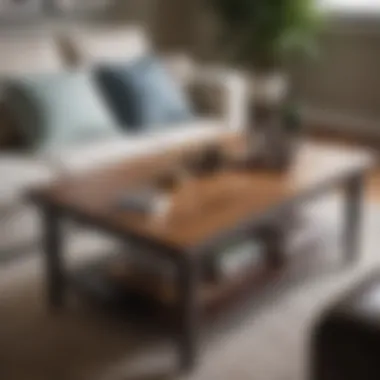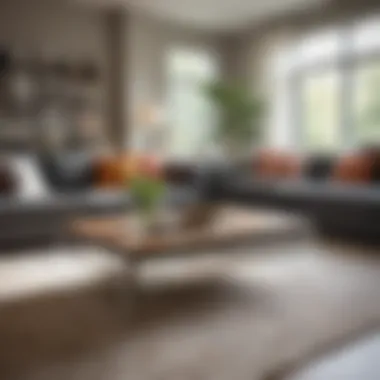Center Couch Tables: Selection, Style, and Placement Tips


Intro
In the realm of living spaces, center couch tables play a pivotal role, often acting as the unsung hero of both functionality and style. Whether you’re welcoming guests or enjoying a quiet night at home, the right center couch table can tie a room together, balancing aesthetics with practicality. Understanding the various options, styles, and placements available can greatly enhance the way you interact with your environment.
This guide takes a closer look at these often-overlooked pieces of furniture. By exploring the spectrum of styles, materials, and their effective arrangement in a room, you can create a living area that is not only visually appealing but also functional. Let’s journey through the fascinating world of center couch tables, starting with an overview of popular furniture styles.
Understanding Center Couch Tables
Center couch tables serve more than just a functional purpose; they are pivotal to the layout and ambiance of living spaces. This section aims to unravel the significance of these tables, breaking down their definitions, historical roots, and vital role within our homes.
Definition and Purpose
A center couch table, often known as a coffee table, rests centrally in front of a couch, functioning as an anchor point for the seating arrangement. It’s typically used to hold drinks, books, or decorative items. However, its role extends beyond mere utility. A well-chosen center couch table can exude style and sophistication, instantly elevating the room’s overall aesthetic. From hosting snacks during movie nights to displaying art pieces, the versatility of these tables cannot be overstated.
Historical Context
Historically, center couch tables emerged in the 18th century, reflecting the social customs of their time. Initially, they were simple and functional, inspired by European designs. Over the decades, as homes evolved from formal settings to casual living spaces, so too did the design of these tables. The late 19th and early 20th centuries saw an explosion of creativity, with artisans experimenting with materials and forms. Today, center couch tables incorporate everything from reclaimed wood to sleek metals, each with its distinct flair and story. The journey of these tables mirrors shifts in home life, revealing an evolving narrative of comfort and style.
Importance in Living Spaces
The living room is often considered the heart of the home, a hub for relaxation and socialization. Center couch tables play a crucial role in this environment, facilitating interaction and focusing attention. They provide a flat surface that invites conversation, whether it's gathering around for a board game or enjoying a quiet evening with a book. Additionally, they bridge the gap between seating arrangements, offering a visual and functional connection among various pieces of furniture.
A few reasons they are indispensable include:
- Functionality: Offering space for drinks, snacks, and décor.
- Aesthetic Appeal: Enhancing the visual impact of the room.
- Social Hub: Acting as a central point for gatherings and discussions.
"A center couch table is often the unsung hero of living spaces, quietly supporting comfort and connection."
Types of Center Couch Tables
Understanding the different types of center couch tables is essential for anyone looking to enhance their living space effectively. These tables are not just functional but also serve as a focal point within a room. When considering the vast array of styles, materials, and uses, one can appreciate how a center couch table can reflect personal taste as well as lifestyle needs. These aspects can influence overall room aesthetics and flow, making the selection process both crucial and exciting.
Traditional Styles
Traditional center couch tables often bring a sense of timelessness to a room. Characterized by classic designs, ornate details, and rich materials, they can create an inviting atmosphere that feels warm and familiar. These tables typically feature intricate carvings and wood finishes that stand the test of time. They may include elements like turned legs or decorative elements that lend to their charm. Homeowners who prefer classic decor or a more formal setting might be drawn to these styles, as they easily complement any traditional furnishings.
Modern Interpretations
Modern center couch tables are a breath of fresh air, merging simplicity with functionality. They often emphasize clean lines, geometric shapes, and innovative materials, reshaping our expectations of what a couch table can be. Minimalist designs often make use of metal, glass, or sleek wood finishes, appealing to those who value aesthetics that eschew extravagance. This modern focus not only caters to urban living styles but also complements contemporary furniture beautifully, creating spaces that are both stylish and practical.
Themed Designs
Themed designs take center couch tables a step further by transforming them into statements that resonate with particular styles of living or decor. By veering away from generic design, these tables offer more than mere function; they embody lifestyle essence.
Rustic Ambiance
Rustic ambiance is all about emphasizing natural materials and a sense of warmth. Tables that embody this style often showcase reclaimed wood, which adds character and tells a story of its own. The key characteristic of rustic designs is their imperfect, rugged aesthetic, which can create a cozy, inviting feel in any room. This style is particularly beneficial for homes that aim to promote comfort and a connection to nature. However, while rustic pieces add charm, they can also require more maintenance to keep them looking their best as scratches and dents may show up easier.
Industrial Vibes
Embracing an industrial vibe brings a trendy, urban feel into the home. This style usually features a combination of metal and wood elements, often with a raw, unfinished look. Items like distressed wood topped with a sturdy black metal frame illustrate this appealing juxtaposition of materials. It’s popular because it can seamlessly integrate into loft-style living or homes with an eclectic edge. One advantage of industrial furniture is its durability, although the cold nature of metal might not always scream comfort.
Scandinavian Minimalism
Scandinavian minimalism focuses on simplicity, functionality, and a touch of elegance. Key characteristics include light woods, neutral color palettes, and clean lines. This style promotes a sense of calm, making it an excellent choice for spaces that encourage relaxation and productivity alike. The unique feature of Scandinavian design is its ability to marry beauty with utility effortlessly. However, because of its minimalist approach, one must be conscious of the room's overall decor; too many items may disrupt its serene essence.
Each of these types offers distinct advantages and disadvantages which can significantly influence space dynamics.
Material Considerations
When it comes to center couch tables, the material used plays a crucial role in determining not only the overall appearance but also the ease of use and longevity. Various materials present distinct advantages and drawbacks. Choosing the right material is not just a matter of style; it's fundamental to how the table will function in your daily life and integrate into your home's aesthetic.
Wooden Center Tables
Wooden center tables are considered a classic choice in interior design. The warmth of natural wood can create a welcoming atmosphere that is hard to replicate with other materials. Different types of wood come with their own unique styles, from the elegant, rich look of walnut to the light, airy feeling of maple.
Moreover, wood is durable and can withstand the wear and tear of daily use. It's also versatile, making it easy to pair with many different design styles, whether rustic, traditional, or contemporary. However, wooden tables do require some care. They can be prone to scratches and water damage if not properly maintained. A simple polishing now and then can keep them looking their best. Don't forget that wood can also expand and contract with humidity changes, which could affect stability.
Glass and Metal Compositions
Glass and metal compositions offer a strikingly modern appeal. The transparency of glass creates a sense of space, making it a wise choice for smaller rooms. It reflects light beautifully, enhancing the overall brightness of a space. Meanwhile, metal frames or legs can add a sleek, industrial edge to the design. These kinds of tables can complement modern decor, especially in settings that favor minimalism.
However, there are practical considerations. Glass can be fragile, and while it's generally easy to clean, it can show fingerprints and smudges, requiring more frequent maintenance. Metal, on the other hand, is typically durable but can be susceptible to rust or scratches. A careful choice of materials, such as tempered glass and powder-coated metals, can mitigate these concerns significantly.
Mixed Material Designs
Mixed material designs bring together the best of both worlds—combining wood, metal, glass, and even stone into one cohesive piece. This versatility allows for creative expression while offering functional benefits. For instance, a wooden top paired with metal legs can ground the design while still remaining contemporary and chic.
The juxtaposition of texture can also elevate a living space significantly. Imagine a coffee table with a sleek glass top and wooden storage underneath; it not only serves as a functional piece but also a conversation starter.
One important consideration with mixed materials involves structural integrity. Ensuring that different materials are compatible and securely joined is essential. Proper construction methods, like the use of hidden fasteners or strong adhesives, can result in a lasting piece that doesn't compromise on style.


In selecting a center couch table, the material choices you make will echo throughout your living space, reflecting both your personality and your lifestyle preferences.
By understanding the nuances of each material type, homeowners can better select a center couch table that suits their individual needs, ensuring that it not only adds to the decor but also fulfills functional roles within the space.
Choosing the Right Size
Choosing the right size for a center couch table might seem trivial, but it plays a significant role in the overall function and aesthetic allure of your living space. It’s not merely about picking a table that looks good; it’s about ensuring that it complements the room's dimensions and how people interact within that space. A misjudged size can lead to a cluttered appearance or a table that feels dwarfed in its surroundings, disrupting the balance of your decor.
The size affects not only the visual harmony of the room but also the usability of the table itself. A table that is too large can impede movement or block sight lines, while one that is too small may lack functionality for serving drinks or displaying items. Therefore, understanding the proportions required in relation to your furniture and room is essential.
Proportions to Consider
Room Dimensions
Room dimensions impose a natural framework for the size of your center couch table. Think of your living space as a canvas; the table is the brushstroke that can either enhance or overshadow the picture you are creating. The key characteristic here is proportion—how a table relates to the surrounding space. A larger living room can accommodate a more substantial table, whereas a snug space would benefit from a compact design.
When selecting a table, take these points into account:
- Visual Weight: A heavier table could dominate a small room, giving it a cramped feel.
- Functionality: In larger spaces, smaller tables might look lost and less inviting where they can't perform their role effectively.
- Flow and Movement: Ensure there is ample space around the table for easy navigation, so people can move around without knocking elbows.
Moreover, the location of doorways and walkways can influence your choice. If a table blocks a path, it's an immediate deal breaker. Thus, measuring your room's dimensions carefully creates a roadmap for selecting an ideal center couch table.
Couch Size and Height
The size and height of your couch directly affect the choice of table. Standard couch heights tend to range between 16 to 18 inches from the floor, and the center table should fit seamlessly into that landscape. A common guideline is to keep the table height within 1-2 inches of the couch height to allow for comfortable accessibility for drinks or snacks. Highlighting this characteristic, choosing a table that is too tall can lead to awkward reaches, while one that is too short may feel uncomfortable.
Features to consider regarding couch size and height:
- Scale: A low couch requires a taller table for balance, and if both are too similar in height, it could create a disconnect, visually speaking.
- Aesthetic Appeal: A harmonious relationship between couch and table creates a unified living area that resonates with style.
- Functionality: Consider adding pieces like ottomans that can double as seating or serve as footrests along with the table.
Finding that sweet spot requires a good eye and a tape measure, making sure everything comes together harmoniously.
Practical Guidelines for Sizing
When it comes down to practical guidelines, here's how you can nail the sizing:
- Measure Your Space: Use a measuring tape to mark the area where the table will go, allowing you to visualize proportions.
- Consider the Purpose: What do you want your table to do? If you often host guests, opt for a table that offers ample space.
- Visualize with Tape: Lay down tape on the floor to simulate the table's dimensions. Walk around it; see if it obstructs pathways or feels too cramped.
Color Coordination and Aesthetics
When it comes to center couch tables, color coordination and aesthetics are not just preferences; they’re vital elements that shape the ambiance of a living space. The color scheme can either unify your room or create unsettling contrasts, which may detract from the overall feel. Understanding the psychology of color can guide your choices, ensuring that your selection fits seamlessly with your couch and other decorative elements.
Benefits of Color Coordination
- Creates Cohesion: A well-thought-out color scheme ties various elements of the room together, making it feel harmonious.
- Influences Mood: Colors have unique psychological effects; for instance, blues and greens promote calmness, while yellows and reds can energize the space.
- Enhances Aesthetics: Choosing colors that complement or contrast effectively can elevate the visual appeal of your living space.
Taking into account the various elements and nuances of color can enhance the function and beauty of your center couch table, creating a focal point that draws the eye without overwhelming the space.
Complementary Color Schemes
Neutral Tones
Neutral tones are a versatile choice when it comes to center couch tables. They are often seen as the unsung heroes in design. These shades—like whites, beiges, and grays—serve as a backdrop that allows other colors in the room to pop.
Neutral tones have the unique feature of blending effortlessly with almost any style or color scheme. For instance, a light oak table can complement a contemporary gray sofa while contributing warmth to the space. Their simplicity makes them a beneficial choice for any decor, lending sophistication without stealing the spotlight.
However, one might argue that while neutral tones are inoffensive, they can sometimes feel bland or uninspiring. To combat this, consider adding decorative items like vibrant books or colorful vases atop the table to inject personality into the scheme without overwhelming the space.
Bold Contrasts
On the opposite end of the spectrum are bold contrasts. Tables in striking colors—such as deep reds or vivid blues—can create a dramatic focal point that shakes up your design narrative. A bold-colored table can act as a statement piece that not only serves a purpose but also reflects the personality of the homeowner.
The key characteristic of bold contrasts is their ability to draw attention. For instance, a black table against a white couch creates an eye-catching silhouette that’s hard to miss. It allows for creativity and encourages layering different colors, fabrics, and designs to build visual interest.
However, while bold contrasts can energize a room, they can also be overwhelming if not balanced properly. Too many competing elements can clash, causing visual disarray. Therefore, consider the surrounding colors and elements to ensure a coherent look.
Patterns and Textures
Patterns and textures add another layer of depth to the aesthetics of center couch tables. When you introduce differing textiles—like a woven runner on a glass table or a marble table with textured coasters—you open up a world of design possibilities.
Key Aspects:
- Visual Interest: Patterned surfaces can draw the eye, creating a more engaging atmosphere.
- Tactile Experience: Texture invites touch, enhancing the sensory experience of your space.
Just as color can change the mood, patterns and textures can transform the character of a room. They reveal layers that invite exploration, making a usually static piece of furniture come alive in its context within your decor.
"The right patterns and textures do not just complement colors; they elevate them to new heights of design complexity."
Placement Strategies
Selecting the right placement for your center couch table can significantly affect the functionality and aesthetic appeal of your living space. When done correctly, it not only enhances the overall flow of the room but ensures that the table serves its dual purpose as both a practical surface and a design statement. The strategic placement must consider several factors like the size of the room, the seating arrangement, and the style of furniture leading to a harmonious environment that invites relaxation and conversation.
Optimal Positioning


Positioning a center couch table isn't merely about where it looks good; it’s about how it operates within the space. Commonly, this table sits directly in front of the couch, providing quick access to beverages, snacks, or books. Furthermore, the distance between the couch and the table should be mindful. Generally, it’s advisable to leave between 16 to 24 inches of space. This distance allows guests to move freely while also ensuring that items on the table can be reached with ease.
Here are a few guidelines regarding optimal placement:
- Centering the Table: Aligning the table with the center of the couch creates a balanced aesthetic.
- Consider Viewing Lines: Make sure to position the table without obstructing sightlines, especially in bigger living areas.
- Space for Movement: Ensure pathways remain open for easy movement and interaction.
In smaller rooms, a round coffee table can sometimes work better visually, making the space feel larger compared to a rectangular or square option. In contrast, a larger space may accommodate more robust furniture arrangements, allowing for greater diversity in table shapes and sizes.
“The perfect placement of furniture can create an inviting atmosphere that draws people together.”
Creating Flow and Space
Creating flow in a room means ensuring that furniture pieces work together to promote ease of movement and comfort. When your center couch table is appropriately placed, it facilitates an easy transition from sitting to standing without the risk of bumping into objects.
To enhance flow, consider the following:
- Zone Definition: Identify areas for conversation and relaxation. This will aid in determining where to place the table within these zones.
- Proximity to Other Furniture: The table should complement not only the couch but also other seating arrangements nearby.
- Natural Pathways: Be conscious of how people will navigate the space. A well-placed couch table shouldn't inhibit traffic but should rather guide it.
Different shapes help accomplish these goals differently. For example, a rectangular table may fit perfectly between two couches, while a circular table can soften sharp lines and foster interaction by promoting eye contact.
Integrating your center couch table into the living room’s spatial dynamics can create a sense of unity and purpose within the design. Whether you’re a designer, homeowner or decorator, understanding how to strategically place your center couch table will undoubtedly elevate your interiors.
Integrating Center Couch Tables in Design Themes
When it comes to creating harmonious living spaces, the integration of center couch tables plays a pivotal role. These tables are not merely functional pieces; they serve as focal points that can enhance the overall design narrative of a room. Understanding how to interweave them with various design themes can yield significant benefits, ultimately leading to a cohesive and inviting atmosphere.
Contemporary Settings
In contemporary settings, center couch tables often emphasize sleek, minimalistic designs. The use of clean lines and modern materials can bring a sense of sophistication to the space. For instance, a glass top table with geometric metal legs can create an open feel while providing a surface for decor and utility.
Key considerations here include:
- Color Palette: Sticking to neutral or monochromatic colors allows the table to blend seamlessly with the rest of the decor.
- Functionality: Utilizing tables with built-in storage or unique features, like lift-top designs, align well with contemporary needs for practicality and style.
A great example is incorporating a round marble table that reflects light; this not only serves its purpose but adds a touch of luxury.
Traditional Decor
Integrating center couch tables into traditional decor offers a chance to highlight craftsmanship and timelessness. Here, wooden tables with intricate carvings and rich finishes become centerpieces. They evoke a sense of nostalgia, grounding the space in history and comfort.
Key elements to consider include:
- Material Choice: Solid woods like oak or mahogany can dramatically elevate the ambiance, providing warmth and durability.
- Complementary Styling: Pairing these tables with classic pieces, like a tufted sofa or ornate armchairs, can reinforce the traditional characteristic of the room.
For added charm, consider a rectangular table with a dark stain, layered with vintage books and a couple of antique candlesticks. This adds not just to functionality, but storytelling.
Eclectic Spaces
In eclectic spaces, the possibilities are nearly endless. Here, the goal is to create visual interest through diversity in shapes, textures, and colors. Center couch tables can embody this very spirit, acting as a canvas for personal expression.
Points to keep in mind:
- Mix and Match: Combining different materials like wood, metal, and glass can provide depth. A reclaimed wood table might sit adjacent to a bright, abstract piece of art.
- Personal Mementos: Using the table to display unique artifacts or travel souvenirs can inject personality into the space, transforming it into a conversation starter.
Imagine a colorful patterned table surrounded by an eclectic mix of seating options—a modern sectional paired with vintage chairs—creating a fun and lively area that feels curated over time.
Integrating center couch tables effectively into these varied design themes not only showcases individual style but also maximizes the functional capability of living spaces.
Functional Uses of Center Couch Tables
Center couch tables serve more than just a decorative purpose in a living space; they play pivotal roles in functionality and practicality. Understanding these functional uses can help homeowners and designers make informed decisions when selecting the right table for a specific environment. Whether it’s for entertaining guests, displaying personal items, or simply making the most of the available space, these tables hold significant value in enhancing a room’s usability.
Multi-Functional Tables
In today’s fast-paced world, versatility is key. Multi-functional tables can adapt to varying circumstances, providing an additional layer of convenience. For instance, a center couch table can transform from a casual coffee spot during the day to a dining surface for game nights or gatherings with friends.
- Storage Options: Many multi-functional designs include hidden compartments, enabling the user to tuck away items like coasters, remote controls, or even blankets, keeping clutter at bay.
- Adjustable Heights: Some tables come with adjustable heights to facilitate different activities. Whether it’s sipping coffee or working on a tablet, an adaptable design ensures comfort.
- Convertible Designs: Certain tables can even expand or contract based on need, allowing for various seating arrangements without the hassle of rearranging furniture.
Storage Capabilities
A center couch table can be deceptively spacious. With creative storage solutions, these tables can help maintain a clean and organized living environment. When choosing a couch table, consider designs that offer storage options like drawers or shelves. Here are a few benefits they provide:
- Concealed Storage: Drawers and cabinets can hide away items that would otherwise clutter the tabletop, such as magazines, snacks, or even children's toys. This keeps the surface tidy and visually appealing.
- Open Shelving: On the other hand, open shelves can offer both functionality and style. They provide easy access to frequently used items while also allowing space for decorative touches like books or plant pots.
- Innovative Ideas: Take advantage of unique features like lift-top tables, which can reveal hidden storage while also doubling as a makeshift workspace when needed.
Display and Decor
Center couch tables also serve as focal points in a room, providing opportunities for personal expression and aesthetic appeal. They can be styled to create visual interest or to showcase personality. Here are consideration points to keep in mind:
- Curating Displays: Use space wisely by curating thoughtful arrangements. Grouping items like candles, books, and artwork can create an eye-catching centerpiece that draws the gaze.
- Seasonal Decor: Change your tabletop decor with the seasons. A few simple swaps, like adding autumn leaves or festive ornaments, can refresh the feel of your living space and keep it engaging.
- Balance and Symmetry: When layering decor, aim for balance. Too much clutter can feel overwhelming. Instead, opt for a strategic arrangement that allows for breathing room while also being visually pleasing.
"A center couch table does not just bring functionality; it brings a sense of style and organization that enhances the living area."
Maintenance and Care


In the world of interior design, the saying, "a stitch in time saves nine" holds true. When it comes to center couch tables, regular maintenance and care are not just about preserving aesthetic appeal; they also extend the longevity of a valuable piece of furniture. A center table often stands as a focal point in a living space, capturing attention and facilitating interaction. Hence, attending to their upkeep is paramount for both function and style.
Cleaning Techniques
Keeping a center couch table spotless is essential for maintaining its charm. Depending on the material, cleaning approaches can differ. For wooden tables, a soft, damp cloth paired with a mild furniture polish will often do the trick. For those fashioned from glass or metal, a solution of water and vinegar can provide a streak-free shine. Here are some additional tips for effective cleaning:
- Dust Regularly: Dust tends to settle on tables like uninvited guests. A microfiber cloth can trap particles effortlessly, ensuring your table looks presentable.
- Avoid Harsh Chemicals: Many household cleaners may contain abrasive agents that can mar surfaces. Stick to gentle solutions instead.
- Wipe Spills Immediately: Accidents happen and a quick response can prevent stains or semi-permanent damage. Blot rather than rub, particularly on upholstered surfaces.
- Use Coasters and Mats: Protect the surface from heat and moisture by utilizing coasters for drinks and mats for decorative items.
Preventing Damage
Taking proactive measures to shield your center couch table from potential harm is just as important as cleaning. Here are some strategies for safeguarding your investment:
- Climate Control: Wood, being sensitive to humidity changes, can warp over time. Keep your living space well-ventilated and maintain a consistent temperature.
- Placement Considerations: Avoid putting a table near windows where direct sunlight can fade the finish. Instead, position it strategically in spaces that mitigate exposure yet still catch some natural light.
- Use Furniture Protectors: Felt pads on the bottom of decor items or table legs can prevent scratches. Essentially, these tiny tidbits are your table’s best friend.
- Regular Inspections: Just like we take our car for regular check-ups, don’t overlook your furniture. Scanning for scratches, chips, or loose screws should be part of your maintenance routine.
"Taking care of furniture isn’t just about cleaning; it’s about nurturing over time, ensuring that your space remains a reflection of your style and care."
By embracing a culture of care for one’s center couch table, you reinforce both its functional role and its status as a beloved decor item. With a commitment to the right cleaning habits and protective measures, these tables can shine at the heart of your living space for years to come.
Innovative Ideas for Center Couch Tables
When it comes to center couch tables, innovation can breathe new life into not just the furniture piece itself but the entire living space. While everyone understands the basic function of these tables, integrating creative ideas can enhance both their aesthetic appeal and utility. From seasonal decor to personalized DIY projects, these innovative approaches allow homeowners and designers to express individuality while maintaining the table’s practical purposes.
Why Focus on Innovation?
Incorporating fresh ideas into center couch tables goes beyond mere decoration; it reflects a homeowner’s personality and lifestyle. Seasonal adjustments or DIY alterations can revamp a tired look, ensuring that a room feels both inviting and dynamic. Plus, such innovations often serve multiple functions, maximizing usability without compromising style.
"An innovative center couch table isn't just a piece of decor; it’s a focal point that invites conversation and interaction."
Seasonal Decor Tips
Decorating your center couch table according to the seasons offers an instant refresh that can reinvigorate a space. Wintertime might call for rustic accents, such as pinecones or faux snow, while spring could welcome pastel vases filled with fresh blooms. Here are some practical tips for seasonal decor:
- **Winter:
- **Spring:
- **Summer:
- **Fall:
- Use a cozy table runner with warm, textured fabrics.
- Place a rustic wooden bowl filled with ornaments or scented candles.**
- Introduce vibrant colors with floral arrangements or colorful picture frames.
- A glass cloche on the table can showcase seasonal treasures like eggs or fresh greens.**
- Incorporate light fabrics and breezy decorative accents like driftwood or shells.
- Spread out interesting books or magazines that resonate with outdoor themes.**
- Use earthy tones; pumpkins and gourds can create a homely touch.
- Mixing in candles of varying heights can add warmth and intimacy to the setting.**
Such small shifts not only elevate the table’s look but also align your home with the current mood of each season.
DIY Additions
The allure of DIY projects is well-acknowledged in the world of home decor, and center couch tables are no exception. Implementing DIY ideas enables homeowners to customize their tables. Here are a few engaging projects:
- **Tabletop Coaster Storage:
- **Personalized Table Runner:
- **Repurposed Finds:
- **Artistic Centerpieces:
- Create a beautiful holder for coasters, wrapping them in materials that match your decor.
- A small wooden or metal box can hold them neatly while adding flair.**
- Sew or paint a unique table runner that reflects your style or family history.
- This simple addition can radically transform the look of the tabletop.**
- Use an old ladder or door as a base to create a rustic table.
- Individual shelves can make your table more multi-functional, combining decor and storage.**
- Craft a centerpiece from terrariums or curated collections of small art pieces.
- Not only does this add personalization but it can be an interesting conversation starter.**
DIY projects not just let you flex your creative muscles, but they often also provide a sense of accomplishment while transforming your center couch table into a personalized piece.
In summary, embracing innovative ideas allows homeowners and designers to set apart their spaces. From seasonal decor that evolves with the time of year to creatively crafted DIY projects, the opportunities are plentiful. Each idea serves to make a center couch table a reflection of the individual’s taste and lifestyle, ultimately enriching the living environment.
Culmination: The Role of Center Couch Tables in Modern Homes
Center couch tables have evolved significantly, showcasing not just utility but also a vital role in the aesthetics of modern living spaces. They are not merely functional elements but also serve as focal points in a room, bridging the gap between different areas and facilitating movement. These tables can transform a boring space into something lively and inviting, enhancing the overall vibe of a home.
One cannot underestimate the importance of the right center table in a living room. Their placement often dictates how the space feels, directing traffic and shaping conversations. More than just a table, these pieces can affect the flow and style of the area they inhabit. For homeowners and designers alike, understanding the balance of form and function when choosing a center couch table is paramount. When aligned with the desired theme or motif, a well-chosen table can support the style narrative of a room while also catering to practical needs.
Key considerations include:
- Size: The table should complement the surrounding furniture without overwhelming the space.
- Material: Choices range from robust wood to sleek glass, each defining the ambiance differently.
- Design: Whether it’s minimalist or ornate, the table should reflect the homeowner’s personality and taste.
In essence, center couch tables hold a unique place in living environments, acting as conversation starters while enhancing practicality. Their capacity to unify elements of design cannot be overstated.
Summarizing Essential Insights
In wrapping up the discussion on center couch tables, it is clear that there are numerous aspects to consider when making a choice. Selection is influenced by factors such as size, shape, material, and style. Moreover, it is essential to acknowledge how these tables interact with existing decor. A cohesive design relies on understanding these elements and utilizing them to create synergy within the space.
Some essential insights include:
- Versatility: These tables can adapt to varied themes, from bohemian to modern chic.
- Functionality: Beyond aesthetics, they must provide practical benefits like storage or easy accessibility for everyday items.
- Personalization: Customization options allow homeowners to put their stamp on their furnishings.
Future Trends in Furniture Design
Looking toward the horizon, the world of furniture design is shifting towards more sustainable and multifunctional pieces. As consumers increasingly prioritize eco-friendly materials, we are likely to see a rise in tables made from reclaimed wood or sustainably sourced materials. Furthermore, technology integration might become commonplace, with furniture designed to accommodate charging ports and smart features.
Other notable trends include:
- Modular Pieces: Adaptable designs that allow tables to be rearranged for different uses or aesthetics.
- Mixed Materials: A trend towards combining various elements, such as metal bases with wooden tops, to create a dynamic look.
- Minimalistic Design: As clutter-free living gains traction, the demand for sleek, understated tables continues to grow.
The future of center couch tables undoubtedly lies in innovation while still balancing the timeless needs of functionality and style. Their role will continue to evolve, but the essence of bringing people together and complementing homes will remain constant.







